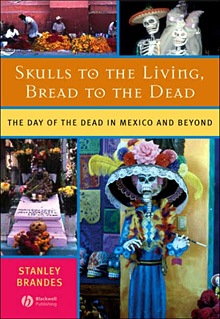
|  |  |  Vallarta Living | October 2008 Vallarta Living | October 2008  
Tourists Love Mexico's Day of the Dead
 Ed Hutmacher - MexicoBookClub.com Ed Hutmacher - MexicoBookClub.com


| | For more information on Dr. Stanley Brandes' 'Skulls for the Living, Bread for the Dead' or other books with Mexico-related themes, please visit MexicoBookClub.com. | | |
Tourists love Mexican spectacles, and nothing is more spectacular than Día de los Muertos. Every year around October 31 to November 2, hordes of tourists descend upon pueblos famous for their Day of the Dead celebrations, expecting to witness an authentic, centuries-old custom of the living communing with the dead. But according to one anthropologist, what tourists often behold is as much contrived theater as it is authentic tradition.

Day of the Dead celebrations vary considerably across Mexico, but few places are as well-known for the way they celebrate Los Dias de los Muertos as the villages located on the shores of Lake Pátzcuaro in the west-central state of Michoacán. There, says every guidebook and travel agent, visitors can still observe the traditional Day of the Dead.

Not so, counters anthropologist Dr. Stanley Brandes in his scholarly tome, Skulls for the Living, Bread for the Dead, in which he goes to great length to shed some historical light on the matter—what modern-day visitors actually witness in those quaint villages bears little resemblance to how townspeople conducted themselves forty years ago, let alone in centuries past.

Up until the early 1970s in the Lake Pátzcuaro region, observing the Day of the Dead was a "minor event" attached to little fanfare, writes Dr. Brandes. Furthermore, he says, the decorated gravesites were modest by today’s standard, and that the late-night vigils were social, semi-religious affairs for family and close friends, living and dead.

Recalling his 1967 anthropological fieldwork as a graduate student researcher in nearby Tzintzuntzan, Dr. Brandes said there was little presence of tourists in the region who expressed the least bit of interest in how the Purepecha Indians practiced their burial rituals. Over the course of the next few decades, however, things would dramatically change.

In 1971, the government launched a large-scale tourism initiative for Tzintzuntzan and other communities in the area of Lake Pátzcuaro, making the Day of the Dead celebration the centerpiece of the program. The result was both successful and disturbing. On the one hand, the influx of tourists stimulated the depressed regional economy. On the other hand, what had once been a relatively minor but culturally significant ritual turned into a wildly commercial, almost carnivalesque enterprise with all the trappings of a happening.

When Brandes returned to Tzintzuntzan in the mid-1990s, he was startled by the transformation brought about by government-sponsored tourism: "Thousands of tourists swarmed through the streets, stomped through the cemeteries, clogged and littered the city streets, and crowded into public spaces to observe cultural performances put on by professional actors and dancers imported from outside the town...

"Everywhere I turned, there seemed to be constant noise and commotion. The worst was the presence of floodlights, garishly illuminating the cemetery in the middle of the night for the purpose of a television event… The town became more or less a great stage prop for a ritual drama. I had hoped for something better, something purer and more authentic. In this drama, native townspeople participate as actors but outsiders run the show."

The entire Lake Pátzcuaro region had gone commercial, and remains so today. Just as the government hoped, it was the dollar-rich tourist who became both the fuel and engine that now powers the three-day extravaganza, evident by the high prices for things no local would ever pay or want.

Most troubling to anthropologists like Dr. Brandes is the loss of the "purer and more authentic" element to Day of the Dead celebrations he witnessed in the 1960s. Tour buses, RVs and SUVs now line the road to the various cemeteries a half-mile deep. Tourists carrying plastic cups filled with god-knows-what sway and sing along to boom-boxed music and mariachi ensembles, making the whole affair seem like a tailgate party while turning a family’s nighttime vigil and their cemetery into a kind of amusement park.

It’s an anthropologist’s lot to make sense of all this cross mixing of cultures brought about by mass tourism and economic activity, and in this regard Dr. Brandes speaks matter-of-factly:

"There is and never has been an authentic Day of the Dead. Through vast expanses of space and time, there have emerged many different Days of the Dead, each responding to the needs and aspirations of local celebrants."

Yes, the Day of the Dead has strayed far over the last forty or fifty years from its mid-20th century traditions, but not as far as it has strayed over the last five hundred years from its pre-colonial roots. And it’s worth recalling that it was Cortez, along with his God-fearing missionary cohorts aboard the all-inclusive Spanish cruise ship HMS Conquest, who first introduced Mexico to the benefits of mass tourism.

Have you ever wondered how indigenous Mexican Indians celebrated the Day of the Dead before that?

Ed Hutmacher is Editor in Chief of mexicobookclub.com. To read more about the book mentioned in this column, or other books with Mexico-related themes, please visit the website. |

 |
|  |



